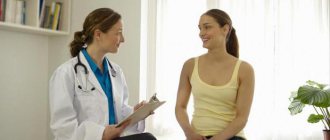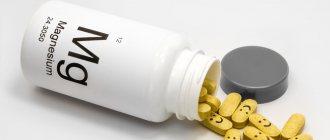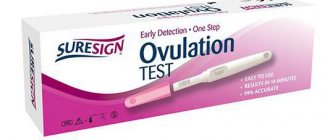The release of an egg from the ovary into the pelvic cavity as a result of rupture of a mature follicle. From the pelvic cavity, the egg enters the fallopian tube, where fertilization occurs. The biological meaning of ovulation is the release of the egg from the follicle for its fertilization and further transportation through the reproductive tract. With a 28-day menstrual cycle, ovulation occurs on the fourteenth day. A few days before and after ovulation are the most favorable times for fertilization of the egg.
A girl's ovaries contain a large number of eggs from birth. Not all reproductive cells survive to the age when puberty occurs, but those that remain are quite ready for their main function - the formation of a new organism.
Every month, one (less often several) egg matures in the ovaries of a sexually mature girl, which at a certain moment leaves its vesicular membrane (follicle) and enters the fallopian tube. Modern medicine calls such a complex process ovulation. Without it, it is impossible to get pregnant naturally.
Surely, more women will be interested in knowing how exactly ovulation occurs, at what interval, and what to do if the favorable period for conception does not occur?
The process of ovulation is the rupture of the vesicular follicle and the release of a reproductive cell that is ready for fertilization. Instead of the ruptured dominant structural component of the ovaries, a temporary gland (corpus luteum) appears. It is she who synthesizes hormones during ovulation and produces progesterone, which helps thicken the lining of the uterus, which prepares for pregnancy. If fertilization does not occur, after 11-15 days the corpus luteum stops developing. Against the background of this process, the thickened mucous part of the uterus is rejected, tearing small blood vessels. Menstrual bleeding begins.
The menstrual cycle takes place from the first day of the previous menstruation to the first day of the next. The duration of such a cycle can vary and, as a rule, ranges from 22 to 32 days.
Dates and day of ovulation
Not all women know how many days ovulation lasts and what is the viability of a mature egg. The exit of the reproductive cell from the follicle takes approximately 60 minutes. And once in the fallopian tube, the egg remains ready for conception for approximately 22-26 hours.
How many days does ovulation last in a normal cycle?
It is important to highlight the fact that ovulation can occur differently for each woman. The norm in medical practice is considered to be the period from the 11th to the 16th day of the menstrual cycle. The regularity of the phenomenon depends on numerous factors, including the hormonal balance that is created by the follicular hormones of the ovaries and the anterior lobe of the endocrine gland (pituitary gland). Ovulation lasts approximately 16-32 hours.
Early ovulation
Reproductive health experts note an average value that determines the period of time when, as a result of a ruptured follicle, an egg from the ovary enters the fallopian tube. Considering the exact timing of the onset and how many days ovulation lasts, we can safely say that such a physiological process most often occurs in the middle of the menstrual cycle.
The early ovulation cycle is the release of an egg ready for fertilization on days 7-10 from the first day of menstruation. Most doctors are confident that this concept is correct to use only when diagnosing the reproductive system of one woman. That is, if over a certain period of time a girl’s ovulation began only on the 15-16th day of the cycle, and in one period it occurred on the 9th day, then it is in this case that it is appropriate to use the term “early ovulation.” Indeed, for some women, the day of ovulation falling on the 9th day of the cycle is the norm.
There may be several reasons for the appearance of an early phenomenon associated with the rupture of the follicle and the release of a mature egg into the fallopian tube. Medical specialists highlight not only hormonal fluctuations, but also chronic diseases, taking pills, and even a sudden change in environment.
Problems with brain activity can trigger the development of an early ovulation cycle. If the hypothalamus produces a large amount of gonadotropin, the pituitary gland, in turn, will immediately produce hormones that will trigger the process of follicle rupture and the release of the egg ahead of schedule.
Late ovulation
The days of ovulation that fall at the end of the menstrual cycle (from the 18th day from the first day) can be considered late if, over a certain period of time, the release of the egg from the follicle in a woman occurred at an earlier date.
Late ovulation can become a hindrance when planning a child, because in this way you can miss the right moment for conception. Also, late periods can increase the risks of an unwanted pregnancy, because women often use an ineffective method of contraception associated with calendar calculation of the days of the cycle. It is necessary to treat the problem with medication by a gynecologist only if it is proven that early or late ovulation is a sign of disorders.
Are you planning a pregnancy? Do you know what hormone tests you need to take?
Hormones produced by endocrine glands are responsible for regulating growth, metabolism, and the formation of female or male sexual characteristics. Hormonal levels are important when conceiving and carrying a child. Any failures or deviations from the norm lead to disturbances during pregnancy, spontaneous abortions, fetal death, and infertility.
To determine the state of hormonal levels when planning pregnancy, many women are prescribed hormone tests. They allow you to determine the cause of the disorders and prescribe the necessary medications to normalize the condition.
Signs of ovulation
All existing signs of ovulation can be divided into several subgroups, among which objective and subjective symptoms should be distinguished:
- short-term pain syndrome in the lower abdomen;
- excess discharge that becomes mucous and sticky;
- decreased body temperature in the colon;
- increase in progesterone concentration, etc.
All signs of the phenomenon should be considered in detail, because such knowledge will help to recognize the symptoms and accurately calculate ovulation.
Pain syndrome during ovulation
During ovulation, approximately every 4-5 women experience pain in the lower abdomen. Doctors in this case note several provoking factors.
The day of ovulation may be accompanied by pain associated with minor bleeding that appears in the ovary when the follicle ruptures. This process irritates the abdominal wall, after which, as a rule, short-term pain appears. The degree of pain largely depends on the woman’s body. The nature of the pain can be dull or sharp. The duration of this sign of ovulation ranges from a few seconds to hours.
It is important to highlight the fact that painful ovulation, the symptoms of which can have varying degrees of manifestation, is a physiological process.
Signs of the phenomenon are associated primarily with the peculiarities of the structure of the woman’s reproductive system. Pain in the middle of the cycle, as a rule, is not pathological and does not require consultation with a specialist. But it also happens that unpleasant sensations are not associated with rupture of the follicle, but appear for a number of other reasons, for example, due to appendicitis.
You should immediately go to the hospital and make an appointment with a doctor if:
- painful signs of ovulation are accompanied by an increase in body temperature and nausea;
- sharp or dull pain becomes unbearable;
- pain during ovulation does not go away after 24 hours;
- the day after ovulation is accompanied by dizziness or heavy bleeding.
If you cannot quickly get an appointment with a leading doctor, you should immediately call an ambulance.
Discharge during ovulation
Among the main signs of ovulation, features of vaginal secretion can be noted. During the period of rupture of the follicle and the release of the egg into the fallopian tube, the discharge increases in volume and becomes more viscous. The color may become clear, white or yellowish-beige. Normally, such discharge should not be accompanied by redness of the skin, swelling, itching, burning or a strong odor.
Hormonal changes during ovulation
At the site of the ruptured follicle, a gland (corpus luteum) appears, capable of producing steroid hormones.
Estrogen
Steroid hormones estrogens are divided into 3 fractions, which need to be considered according to their activity:
- estrone (less active);
- estriol;
- estradiol (the most active).
Hormonal levels change throughout the menstrual cycle. In particular, the amount of estrogen increases during follicle growth. Ovulation is directly related to an increase in estrogen levels.
Cyclic hormonal changes in progesterone and estrogen levels lead to a transformation of the endometrium, which is ready to receive an already fertilized egg.
Progesterone
During ovulation and before the onset of menstrual bleeding, the temporary endocrine gland (corpus luteum) actively produces progesterone. It connects to estrogens, which from the very beginning of follicle growth changed the hormonal background, making it favorable for fertilization and development of the embryo.
Taking into account the above information, we can summarize and confirm the fact that the production of estrogen occurs mainly during the period of follicle growth, but progesterone begins to actively grow during the emergence and development of the corpus luteum.
The hormones that the ovaries synthesize affect many tissues of the human body, including the mammary glands, brain, skin, myocardium, etc.
How to determine ovulation, methods and methods
To calculate ovulation for conception or simply determine its timing, you can use several methods. Among the most popular methods are ovulation tests and ultrasound diagnostics. It is these options that will help you find out exactly when and how many days ovulation can last in your particular case.
Ovulation calendar
You can conditionally calculate ovulation using a special calendar. This method can help not only determine approximate safe days for sexual intercourse, but also a favorable period for conception. A gynecologist can help create an ovulation calendar.
Based on the patient’s personal data, the doctor will draw up a schedule with approximate dates. It is important to know that you cannot use an ovulation calendar for contraception. This method does not guarantee and will not protect against pregnancy.
Ovulation calculator
You can get an approximate calculation of ovulation using an automatic online calculator, but it is important to use it only in combination with other effective methods. Comprehensive diagnostics during the period when a mature egg enters the fallopian tube can take into account the results of an ultrasound examination, test and data from an ovulation calculator.
You can calculate ovulation for conception using some information. It is important to note when the first day of your last menstruation was and the length of your cycle. The ovulation calculator calculates the conditional schedule automatically. This method cannot be used as protection against unwanted pregnancy.
Ovulation test
An accurate and compact ovulation test is an excellent way to plan pregnancy. It is easy to use and delivers accurate results most of the time. This method works based on a woman’s hormonal background, which changes rapidly throughout the menstrual cycle.
Peptide luteinizing hormone (LH) is necessary for the full functioning of the reproductive system. A peak increase in its indicators initiates ovulation, which is what the tests focus on. The time when an egg ready for fertilization leaves the follicle can be determined using calculators, ovulation calendars, and basal temperature. But it is the ovulation test that is considered the most likely way to determine favorable days for conception. Although it may vary in its characteristics and accuracy.
It is important to know that the test does not show when the egg leaves the follicle, but only determines the level of LH.
Electronic tests
The electronic digital ovulation test is designed for reusable use. The appearance of this product vaguely resembles a classic lipstick case. You can purchase the product at a pharmacy. Ask your doctor for advice.
Test strips
The ovulation test in the form of strips is made of paper and has a control mark. Determining ovulation at home using this method is not difficult.
- Immerse the test strip to the acceptable level in the clean container where the urine was collected.
- Wait for the specified period of time indicated in the instructions.
- Evaluate the result.
It is worth highlighting portable systems that operate on a reusable principle. Such tests consist of strips designed to be dipped into urine and an electronic “controller”. Experts highlight this method as one of the best for determining ovulation.
Inkjet tests
You can calculate ovulation for conception using jet tests. This method of calculating hormone levels does not require urine collection. Use a special strip with a reagent while urinating, placing the test under the stream. Results can usually be seen within a few minutes. Before use, be sure to read the instructions that come with the product.
Experts advise reducing the amount of fluid consumed several hours before using the test to make the urine more concentrated.
The test can give a negative result if:
- the release of a mature egg from the follicle does not occur at the moment (it is important to note that already a day after ovulation, the LH level begins to fall);
- you bought an expired, damaged product or cheap, uncertified product.
During the ovulatory period, the test is carried out over 4-5 days. The timing of determining the release of an egg will depend on the length of the menstrual cycle of a particular woman. Testing is performed 2 times a day, in the evening and morning, so as not to miss an important moment.
If you know how to determine ovulation and have identified favorable days for fertilization (the test showed clear two stripes), then you can start conceiving immediately. But it is best if conception is planned before ovulation.
Ultrasound monitoring
There are several ways to calculate the time of ovulation for conception. According to many experts, ultrasound monitoring is the most informative. Diagnostics of this type allows not only to monitor the formation and development of the follicle, but also to monitor malfunctions in the functioning of the woman’s reproductive system. An ultrasound will determine the condition of the uterus, appendages and ovaries, detect cysts and other types of formations, help evaluate changes in the endometrium, the appearance of the corpus luteum, etc. A doctor will help establish the approximate dates for the beginning, peak or end of ovulation using ultrasound monitoring.
It is important to know that the above diagnostic method also has its limitations. Using mechanical high-frequency vibrations it will not be possible to determine the patency of the fallopian tubes and the presence of adhesions. In this case, hysterosalpingography is used to determine patency.
How to calculate ovulation for conception using basal temperature
Not many girls know that you can determine the ovulatory period at home by measuring body temperature in the rectum. The variability of such indicators in a healthy person appears due to progesterone.
Basal temperature is determined in the morning (immediately after waking up). It is advisable to carry out the procedure daily at the same time for 3-5 menstrual cycles. It is important to enter all research results into a special calendar, which you then need to show to the doctor. You also need to know that you should measure your temperature carefully for several minutes with a mercury medical thermometer.
Doctors note that thanks to basal temperature, the cycle can be divided into 2 phases - before and after ovulation. In the first period, approximately 10-14 days from the start of menstruation, the temperature most often ranges from 36.2 to 36.8 degrees. A sharp increase in readings (over 37°C) in a healthy person may indicate rupture of the follicle and release of the reproductive cell. Such elevated body temperature in the rectum, as a rule, lasts until the end of the cycle.
This type of diagnosis is not effective and cannot predict the peak of the process or, for example, determine the days after ovulation. Testing by measuring basal temperature cannot be used to identify disorders in the reproductive system. Based on the results, it is prohibited to purchase medications on your own. Any self-medication can harm your health.
The nature of cervical (cervical) mucus
During ovulation, under the influence of estrogen, changes occur in the mucous membrane of the cervix. The discharge becomes transparent, viscous and may visually resemble the white of a fresh chicken egg.
But you won’t be able to tell for sure about ovulation based on the nature of your cervical mucus. After all, this sign can only be used to determine fluctuations in the level of estrogen hormones, and they, in turn, can be observed during ovulation, pregnancy, and even during menstruation.
Ovulation disorders
Numerous factors can affect ovulation, including neoplasms of the ovaries and appendages, diseases of the female reproductive system, endocrine problems, hormonal imbalance, etc.
Major ovulation disorders and cycle regularity
The ovulation cycle may be disrupted after an abortion or childbirth. With artificial termination of pregnancy, the recovery period usually takes 2-4 months. Also, the day of ovulation will be difficult to predict after delivery (the cycle is restored within one year).
Physical exercise
Due to prolonged and significant physical activity, against the background of severe systematic fatigue of the body, disruptions in the menstrual cycle and ovulation disorders are possible.
Eating disorders
Extra pounds can cause infertility. In overweight women, fat deposits accumulate and hormonal imbalance occurs. Such disorders, in turn, can delay or even stop the process of ovulation in the female body. The same applies to sudden weight loss. Rapid weight loss often disrupts the monthly ovulatory cycle. As a result, menstruation may be completely absent.
Endocrine factors
Benign and malignant neoplasms, blood supply disorders, taking certain medications - all this can affect the pituitary gland and provoke hormonal imbalance. One of the most common diseases of the gland is prolactinoma, causing hyperprolactinemia. Elevated levels of prolactin in the blood most often cause infertility and ovulation disorders.
Thyroid diseases can also cause disruption of a woman’s reproductive functions. Both hypothyroidism (lack of hormones) and hyperthyroidism (excess hormones) disrupt ovulatory processes.
Unruptured follicle
Unruptured follicle syndrome is one of the most common causes of infertility in women. With this pathology, the egg does not enter the fallopian tube. The follicle develops, but does not expel the reproductive cell for further fertilization. Subsequently, it turns into a corpus luteum or a benign formation (cyst). Pregnancy does not occur after such ovulation.
There is no consensus explaining the causes of unruptured follicle syndrome. But doctors do not rule out hormonal disorders and chronic ovarian diseases.
Luteal phase deficiency
The menstrual cycle can be divided into two distinct periods:
- the follicular phase begins on the first day of menstruation and ends during ovulation;
- The luteal phase begins the day after ovulation and ends on the last day of the cycle (before menstruation).
Luteal phase deficiency is a malfunction of the temporary endocrine gland (corpus luteum), which appears at the site of the follicle. Symptoms of the problem may include:
- delays in the menstrual cycle;
- heavy or scanty discharge during menstruation;
- infertility, miscarriage, etc.
Luteal phase deficiency can develop due to hormonal imbalance, diseases of the reproductive system, medical abortion, fasting and other reasons.
Which doctors should I contact if I have ovulation problems?
It is important to diagnose and treat problems associated with ovulation under the strict supervision of a specialist. Any self-medication is fraught with negative consequences, which, most likely, will be difficult to eliminate completely later.
If pregnancy does not occur after ovulation, you feel alarming symptoms or your menstrual cycle is constantly confused, then you need to seek help from a gynecologist as soon as possible. If your problems are related to hormonal imbalances, then it would be advisable to visit a gynecologist-endocrinologist. Such a specialist has primary specialization in gynecology and obstetrics, and is also competent in issues of the endocrine system.
Forms of anovulatory infertility
The congenital form of pathology occurs as a result of mutation of genetic material. Acquired occurs due to the occurrence of dangerous diseases, these include:
- anorexia;
- Sheen's syndrome;
- disturbance of the psycho-emotional background;
- increased physical activity.
p, blockquote 28,0,0,0,0 –>
Hyperprolactemia is an independent form. According to statistics, with hormonal infertility, this type accounts for 40% of cases. Increased production of prolactin leads to secondary infertility. h2 7,0,0,0,0 –>
Ovulation stimulation
Timely and high-quality stimulation of ovulation can demonstrate positive results. This procedure is not carried out for everyone. The methods have their contraindications and risks, which are important to consider.
Use of ovulation induction
Today, ovulation induction is a complex system of actions aimed at stimulating the receptors of the glands of the genital system. The procedure is carried out to create optimal conditions in the girl’s body for the rupture of the follicle and the release of the egg.
Hypothalamic-pituitary dysfunction
Often, due to significant physical activity, stress and other reasons, the pituitary gland cannot produce sufficient amounts of luteinizing and follicle-stimulating hormones. Hypothalamic-pituitary dysfunction appears, which can be eliminated through carefully selected drug treatment.
Gonadotropins are hormones that regulate the reproductive function of the body and are produced by the pituitary gland. If the gland does not produce enough luteinizing and follicle-stimulating hormones, then gonadotropins are administered medicinally, intramuscularly or subcutaneously. There are two types of such medications.
- The Humegon brand in the United States and several other companies produce a hormonal medicine with equal amounts of luteinizing and follicle-stimulating hormones.
- "Gonal F" or "Follistim" offer a drug containing follicle-stimulating hormone. The product was created thanks to innovative technologies and genetic engineering. Shows good results.
Treatment of ovulation problems with gonadotropins is prescribed by a doctor and requires strict medical supervision. Therapy lasts for 10 days and begins on the 3rd day of the start of the menstrual cycle. Throughout the treatment, ultrasound diagnostics are performed daily to monitor follicle growth. After the structural component of the ovaries has matured, hCG is administered, after which the ovulatory period begins. The method involves the full maturation of 1-3 eggs, so doctors do not rule out multiple pregnancies.
There is another method of induction (stimulation of ovulation). It is carried out using a hormone (gonadotropin-releasing type). The substance affects the pituitary gland.
Polycystic ovary syndrome
Polycystic ovary syndrome is a polyendocrine syndrome, which is characterized by disturbances in the functioning of the woman’s reproductive system. For multiple reasons, a large number of cysts of different sizes are formed. Ovarian function is impaired. Symptoms of ovulation may be absent; an increase in the level of estrogen and androgens in the blood is often observed.
To stimulate ovulation, women with polycystic ovaries are sometimes prescribed clomiphene citrate. Treatment begins on the third day from the beginning of the menstrual cycle. The course of therapy can take from 5 to 7 days.
It is important to treat polycystic ovary syndrome only under the supervision of a specialist. The problem requires careful diagnosis and complex therapy with effective medications. Any self-medication can aggravate the situation and provoke the occurrence of adverse reactions, including allergies.
Endocrine disorders
Hypothyroidism (lack of thyroid hormones) can cause reproductive failure. Comprehensive and timely treatment of the thyroid gland can restore secretion and eliminate ovulatory dysfunction.
An endocrinologist can prescribe treatment. After a full diagnosis, based on the results of laboratory tests, the doctor will select the optimal safe therapy. Any self-medication is fraught with negative consequences. Experimenting with your health is dangerous, so you should seek help from a doctor.
In Vitro Fertilization
IVF is one of the best methods of modern infertility treatment. A mature egg is removed from the female body and fertilized under artificial conditions. With such manipulations, ovulation is most often stimulated with the help of hormonal medications.
Success of ovulation induction
According to statistics, in case of hypothalamic-pituitary dysfunction, stimulation of ovulation is successful in 80-90% of all cases (after 6 cycles of therapy). In women with polycystic ovaries, these rates are slightly reduced.
As for artificial insemination (IVF), success may depend on numerous factors, including sperm activity.
Side effects of ovulation induction
The main side effect of ovulation stimulation is multiple pregnancy. 15-30% of girls who took gonadotropins have twins. It is important for women carrying multiple fetuses to be aware of the risks of preterm birth.
Stimulating ovulation with clomiphene or gonadotropins can provoke the appearance of unpleasant symptoms: headaches, etc.
Among the side effects of ovulation induction, it is worth highlighting ovarian hyperstimulation syndrome. A dangerous disorder occurs rarely, but doctors believe that it is better to prevent the syndrome than to treat it later. Symptoms of the problem may include vomiting and nausea, as well as difficulty breathing. Because of the potential risks, doctors practice careful monitoring of the woman’s condition (ultrasound and blood tests) during stimulation of the ovulatory process.
What drugs restore hormonal levels?
The treatment plan is drawn up by the gynecologist together with the endocrinologist. At the same time, they take into account the reason that led to the hormonal imbalance, as well as secondary factors, these include:
- age;
- nutritional features;
- sexual activity;
- clinical manifestations;
- diseases.
p, blockquote 21,0,0,0,0 –>
Drugs for restoring hormonal levels can be divided into hormonal and non-hormonal. The former are highly effective, but cause side effects and have contraindications, the latter are more gentle, but such therapy may be delayed. p, blockquote 22,0,0,0,0 –>
Phytoestrogens are substances of natural origin; they are one of the key elements in the composition of plants. Their structure resembles human estrogens. Preparations with phytoestrogens are prescribed when hormonal drugs are contraindicated for a woman. The most effective include:
- Remens. Eliminates estrogen deficiency, regulates the psycho-emotional state of a woman, eliminates pain.
- Climaxan. One of the most effective and safe medications during menopausal syndrome, which causes headaches, hot flashes, excessive sweating and irritability.
- Tribestan. The main component of the product is Tribulus plant extract. It contains steroid saponins and improves the functioning of the reproductive system.
- Estrovel. Replenishes estrogen levels in the body, improves psychophysical condition.
p, blockquote 23,0,0,0,0 –>
Therapy using drugs with sex hormones is considered replacement therapy. As a rule, the specialist prescribes treatment in cycles, which continues until menopause is completely restored. Medicines containing the following hormones show excellent results:
- Progesterone (“Eroton”, “Oxyprogesterone”, “Progestin”);
- Estrogen (“Octestrol”, “Dimestrol”, “Sigetin”, “Diethylstilbestrol”).
p, blockquote 24,0,0,0,0 –>
It is strictly prohibited to prescribe the use of such drugs on your own, since if taken incorrectly there is a high probability of side effects, including complete loss of reproductive abilities. h2 5,0,0,0,0 –>
Pregnancy after ovulation
In modern gynecology, the beginning of pregnancy is considered to be the first day of the last menstruation. If you are planning to have children, it is important to visit your gynecologist as early as possible. Pregnancy after ovulation can occur naturally or through medical intervention. In any case, you cannot do without consulting a specialist.
First day after ovulation
Normally, eggs begin to develop inside a woman's ovaries every month. One of the cells completes its maturation and leaves the “capsule” (follicle) in which it was located. The egg enters the fallopian tube, where it remains to await the sperm for fertilization.
It is almost impossible to answer unequivocally how many days ovulation can last, but the reproductive cell lives after leaving the follicle for about 22-26 hours. If the egg is not fertilized during this time, it degenerates.
Conception and gender of the child
Once inside the egg, the sperm activates the defense system. Changes occur in the protein shell of the reproductive cell, which prevents the subsequent penetration of other sperm. It is in the first few days after ovulation and successful fertilization that genetic information about the embryo is laid down and the sex of the unborn child is formed.
A woman has only type X chromosomes. A man has one Y and the other X. If the egg is fertilized by sperm-X, then a girl will be born, and if Y, then there will be a boy.
Ovulation after childbirth
Doctors strongly recommend not planning a pregnancy immediately after delivery. It is important to maintain a minimum annual interval in order to give all body systems a rest. Postpartum conception may increase the risk of complications, especially if the previous birth was difficult.
The menstrual cycle is restored after childbirth within a year, although the timing largely depends on the individual characteristics of the woman’s body. The recovery period is also affected by lactation, in which the hormone prolactin suppresses the hormones produced by the ovaries. This is why symptoms of ovulation most often do not occur.
It is important to know that pregnancy after ovulation can occur without the restoration of the menstrual cycle. The thing is that after childbirth, the first ovulatory period occurs approximately 14 days before menstrual bleeding. Therefore, it is imperative to take precautions and regularly visit a gynecologist. Remember that prevention is always better than the disease itself.
Symptoms of hormonal infertility
The main manifestation of hormonal imbalance is prolonged unsuccessful attempts to conceive a child. However, there are other equally characteristic clinical manifestations:
- menstrual irregularities;
- delays;
- anovulation;
- severe manifestations of PMS;
- regular cystitis;
- chest discomfort;
- dirty brown discharge;
- formation of stretch marks and acne, hair loss, hypertrichosis.
p, blockquote 26,0,0,0,0 –>
Even by examining the manifestations, a specialist can determine which hormone is causing the problem. That is why taking an anamnesis is an important stage of diagnosis. h2 6,0,0,0,0 –>











